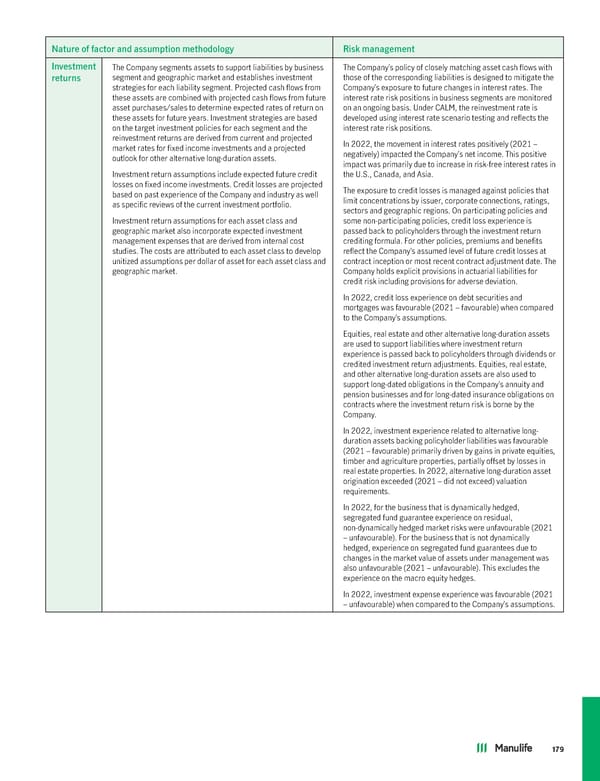Nature of factor and assumption methodology Risk management Investment The Company segments assets to support liabilities by business The Company’s policy of closely matching asset cash flows with returns segment and geographic market and establishes investment those of the corresponding liabilities is designed to mitigate the strategies for each liability segment. Projected cash flows from Company’s exposure to future changes in interest rates. The these assets are combined with projected cash flows from future interest rate risk positions in business segments are monitored asset purchases/sales to determine expected rates of return on on an ongoing basis. Under CALM, the reinvestment rate is these assets for future years. Investment strategies are based developed using interest rate scenario testing and reflects the on the target investment policies for each segment and the interest rate risk positions. reinvestment returns are derived from current and projected In 2022, the movement in interest rates positively (2021 – market rates for fixed income investments and a projected negatively) impacted the Company’s net income. This positive outlook for other alternative long-duration assets. impact was primarily due to increase in risk-free interest rates in Investment return assumptions include expected future credit the U.S., Canada, and Asia. losses on fixed income investments. Credit losses are projected The exposure to credit losses is managed against policies that based on past experience of the Company and industry as well limit concentrations by issuer, corporate connections, ratings, as specific reviews of the current investment portfolio. sectors and geographic regions. On participating policies and Investment return assumptions for each asset class and some non-participating policies, credit loss experience is geographic market also incorporate expected investment passed back to policyholders through the investment return management expenses that are derived from internal cost crediting formula. For other policies, premiums and benefits studies. The costs are attributed to each asset class to develop reflect the Company’s assumed level of future credit losses at unitized assumptions per dollar of asset for each asset class and contract inception or most recent contract adjustment date. The geographic market. Company holds explicit provisions in actuarial liabilities for credit risk including provisions for adverse deviation. In 2022, credit loss experience on debt securities and mortgages was favourable (2021 – favourable) when compared to the Company’s assumptions. Equities, real estate and other alternative long-duration assets are used to support liabilities where investment return experience is passed back to policyholders through dividends or credited investment return adjustments. Equities, real estate, and other alternative long-duration assets are also used to support long-dated obligations in the Company’s annuity and pension businesses and for long-dated insurance obligations on contracts where the investment return risk is borne by the Company. In 2022, investment experience related to alternative long- duration assets backing policyholder liabilities was favourable (2021 – favourable) primarily driven by gains in private equities, timber and agriculture properties, partially offset by losses in real estate properties. In 2022, alternative long-duration asset origination exceeded (2021 – did not exceed) valuation requirements. In 2022, for the business that is dynamically hedged, segregated fund guarantee experience on residual, non-dynamically hedged market risks were unfavourable (2021 – unfavourable). For the business that is not dynamically hedged, experience on segregated fund guarantees due to changes in the market value of assets under management was also unfavourable (2021 – unfavourable). This excludes the experience on the macro equity hedges. In 2022, investment expense experience was favourable (2021 – unfavourable) when compared to the Company’s assumptions. 179
 2022 Annual Report Page 180 Page 182
2022 Annual Report Page 180 Page 182